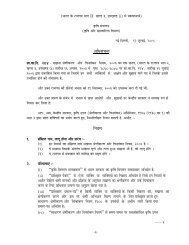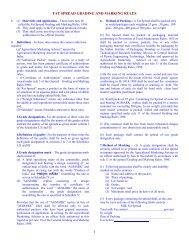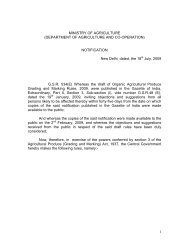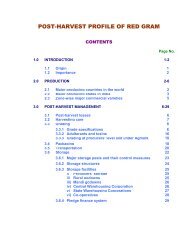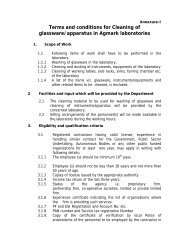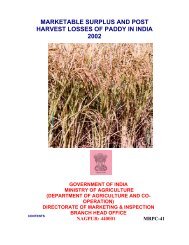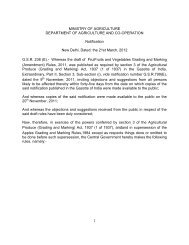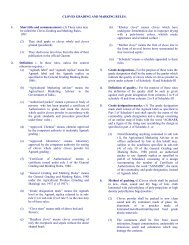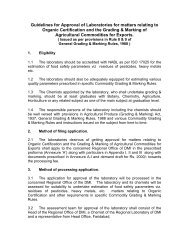Post-Harvest Profile of Grapes - Agmarknet
Post-Harvest Profile of Grapes - Agmarknet
Post-Harvest Profile of Grapes - Agmarknet
Create successful ePaper yourself
Turn your PDF publications into a flip-book with our unique Google optimized e-Paper software.
Disorders:<br />
i) Water Berries:<br />
Water berry is associated with fruit ripening and most <strong>of</strong>ten begins to develop<br />
shortly after berry s<strong>of</strong>tening. The affected berries become watery, s<strong>of</strong>t, and flabby<br />
when ripe. They are almost normal in size but their flesh is not firm. They shrivel and<br />
dry by the time <strong>of</strong> harvest. Such berries mostly confine to the tip <strong>of</strong> the main rachis or<br />
its branches. This disorder occurs due to dense cultivation and inadequate<br />
nourishment available to all the berries in a cluster. Excessive irrigation and<br />
nitrogenous fertilizers should be avoided during berry development to reduce waterberry<br />
formation.<br />
ii) Cluster-Tip Wilting:<br />
Light brown lesions on the apical end <strong>of</strong> the rachis affect the conductivity <strong>of</strong> the<br />
rachis. This results in shriveling and drying <strong>of</strong> the rachis at the tip <strong>of</strong> the bunch. Cluster<br />
pinching or berry thinning should be done to reduce excessive crop load on the vines.<br />
Ensuring adequate irrigation during the berry development and protection <strong>of</strong> bunches<br />
from direct sunlight also help in reducing the incidence <strong>of</strong> cluster-tip wilting.<br />
iii) Shot Berries:<br />
Shot berries are smaller, sweeter, round and seedless as compared to normal<br />
berries. They are formed due to delay in pollination and fertilization <strong>of</strong> a few flowers or<br />
due to inadequate flow <strong>of</strong> carbohydrates into the set berries. Boron deficiency,<br />
incorrect application <strong>of</strong> Gibbrellic Acid and girdling are the reasons for shot-berry<br />
formation. Boron or Zinc deficiencies should be corrected. Application <strong>of</strong> GA at proper<br />
stage should be ensured.<br />
iv) Pink Berry:<br />
As the bunch approaches maturity some berries in the bunch develop pink<br />
colour at random. The pink colour changes to dull red colour rendering the bunch<br />
unattractive. Incidence <strong>of</strong> pink berries is low in the early season crop and increases<br />
with the rise in temperature late in the season. Indiscriminate use <strong>of</strong> Etherel for berry<br />
colouration can also cause this disorder. This is a serious problem in Thompson<br />
Seedless variety in Maharashtra.<br />
v) Bud and Flower Drop:<br />
Flowers drop from the clusters just before and after opening. The buds drop on<br />
shaking the panicle. Excessive bud and flower drop results in reduction <strong>of</strong> yield.<br />
Atmospheric temperature, high phosphorus and total salt contents <strong>of</strong> the soil are the<br />
different factors causing this malady. Judicious irrigation practices and canopy<br />
management practices to improve ventilation during the flower development helps to<br />
minimize the flower bud and young berries drop. This phenomenon is prevalent in<br />
North India in the states <strong>of</strong> Punjab, Haryana and Rajasthan.<br />
38




